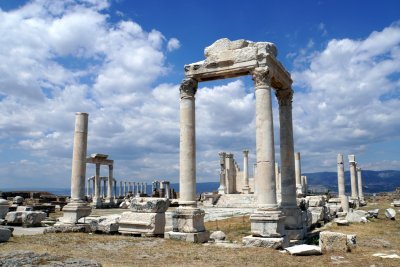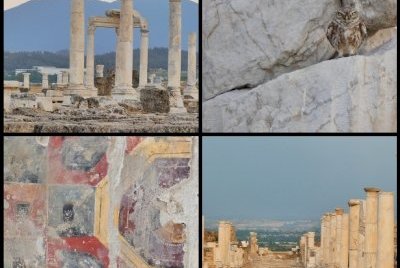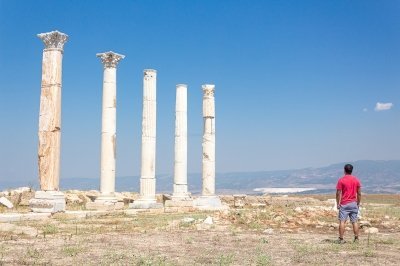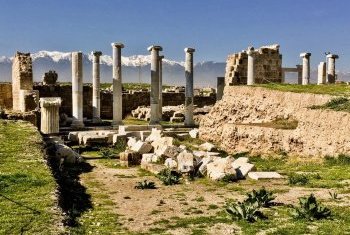Turkiye
Archaeological site of Laodikeia
Laodikeia comprises the remains of a Roman, Hellenistic and early Byzantine city.
The existing remains attest to its former greatness, notably the aqueduct and the stadium. It was also an important site in early Christianity: it had an early church which was mentioned in the Bible.
Site Info
Official Information
- Full Name
- Archaeological site of Laodikeia (ID: 5823)
- Country
- Turkiye
- Status
-
On tentative list 2013
Site history
History of Archaeological site of Laodikeia
- 2013: Added to Tentative List
- Added to tentative list
- Type
- Cultural
- Criteria
Links
- UNESCO
- whc.unesco.org
All Links
UNESCO.org
- whc.unesco.org — whc.unesco.org
Community Information
- Community Category
- Archaeological site: Ancient Greece
- Archaeological site: Ancient Rome
- Archaeological site: Byzantine
Travel Information
Recent Connections
News
No news.
Recent Visitors
Visitors of Archaeological site of Laodikeia
- Alexander Lehmann
- bergecn
- Bin
- Can SARICA
- Carlo Sarion
- Cheryl
- christof
- Christravelblog
- Clyde
- Hasco
- Hubert
- J_neveryes
- Juha Sjoeblom
- Kevin McFarland
- Luke LOU
- Maciej Gil
- Martina Rúčková
- nan
- Patrik
- Rachel Perkins
- Rafał Kałczuga
- Roman Bruehwiler
- Solivagant
- Stanislaw Warwas
- StaziG
- Szucs Tamas
- Thomas Buechler
- Thomas van der Walt
- Tim Allen
- Yevhen Ivanovych
Community Reviews
Show full reviews
If you like taking photos of white columns against a blue sky, Laodikeia is the place to go.Laodikeia is located on a flat hill and offers panoramic views of the surrounding countryside, as far as to the travertine terraces of Pamukkale. The size of the archaeological site is impressive and gives an idea of the importance of the city during its heyday in the late Roman and early Byzantine periods. At that time, it was the second largest city in the province of Asia after Ephesus. Laodikeia was located on important trade routes and gained its wealth mainly through the production of cotton and the trade in textiles. And its proximity to the thermal springs of Pamukkale certainly contributed to its prosperity.
Laodikeia is really a large area. If you arrive by car, you can drive to the café in the middle of the archaeological site after you have passed the ticket office. Right next to the car park is the eastern end of the ancient street that runs through the former centre of the city. Here you should start your visit. Most of the visible remains are located along the remains of this street: the agora, temples and churches, the central baths etc. And all the white columns mentioned at the beginning (the photo shows the re-errected corner columns of Temple A). The best-known building is also located in the central district: an Early Christian Basilica from the 4th century. It was only discovered in 2010 and …
Keep reading 0 comments
I visited this tWHS in Spring 2021 as a side trip on my way back from Aphrodisias WHS. It lies very close to Akhan Caravanserai and the Pamukkale-Hierapolis mixed WHS.
The archaeological site of Laodikeia is practically the remains of a whole ancient city built on the river Lycus (Çürüksu). It was located in the Hellenistic regions of Caria and Lydia, which later became the Roman Province of Phrygia Pacatiana. Apart from the usual colonnaded street, the western theatre, agoras, etc., the highlight for me were the restored fragments (actually a whole jigsaw puzzle of them!) of painted hallways at the far end of the colonnaded street with pigments and motifs very similar to those of the Villa Oplontis in Campania, Italy. Moreover, there are also the remains of one of the seven churches (early Christianity) of Asia mentioned in the Book of Revelation.
Visiting in the late afternoon (ideal to avoid the scorching heat on a sunny day even in Spring!), I had the ancient city to myself and several little owlets that were attentively following me from one column to the next. There seems to be a lot left to be excavated before this site aims for inscription but I wouldn't be surprised if it were to make it on the WH list just like other classical WHS in Turkey. When I visited it was possible to buy a combined ticket to visit Laodikeia and Hierapolis-Pamukkale.
Keep reading 0 comments
Laodikea was an ancient city during the Hellenistic period that was later assimilated into the Roman republic. As it sits on earthquake-prone terrain, it had been rebuilt several times until people have had enough and settled somewhere else. Good thing it was never demolished or completely perished during subsequent earthquakes--otherwise, we won't be able to see these beautiful ruins! It was not really part of my itinerary but having a newly found love for ancient Greek/Roman ruins, I decided to visit Laodikea as my third ancient Hellenistic city within the area of Denizli, after Hierapolis and Aphrodisias. This visit was 3 years ago, in August 2017.
I started the half-day trip by going to Denizli bus station, where I planned to take a public bus that was supposed to go past the site, as mentioned by some sources. Unfortunately, I couldn’t find such bus hence I decided to take a taxi. When I arrived at the site, the taxi driver looked at me as if he was questioning my sanity for going to a rarely visited site alone and in the middle of a hot sunny day.
It was indeed very hot. I went to the only store at the entrance of the site (at the Syrian Gate) and most of what they were selling were souvenirs, cold drinks and ice cream. From what I can remember, the man at the ticket booth was so surprised that a traveler showed up at this time of the day. On …
Keep reading 0 comments
